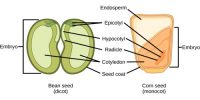In old trees, the greater part of secondary xylem is dark brown due to deposition of organic compounds like tannins, resins, oils, gums, aromatic substances and essential oils in the central or innermost layers of the stem. These substances make it hard, durable and resistant to the attacks of micro organisms and insects. This region comprises dead elements with highly lignified walls and is called heartwood. The heartwood does not conduct water but it gives mechanical support to the stem.
The peripheral region of the secondary xylem, is lighter in color and is known as the sapwood. It is involved in the conduction of water and minerals from mot to leaf.













